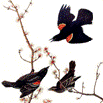Center, Internet, Wildlife Damage Management

Bird Control Seminars Proceedings
Document Type
Article
Date of this Version
November 1979
Abstract
Most of you are familiar by now with ASTM (American Society for Testing and Materials) and the activities of its Subcommittee E35.17 on Vertebrate Pesticides. ASTM's primary business is that of assisting nonpaid, technical volunteers in developing consensus testing standards in a large number of fields. Most of these testing standards or test methods detail how to conduct specific evaluations of a product, or components of a product, based on the best and most current technology available. Consequently, many of these testing standards are used by government or industry for quality control or for regulatory operations and decisions. ASTM subcommittee E35.17 has been active in the vertebrate pesticide field since 1974, developing testing standards for birds, rodents, and predators. The standards that have been developed are diverse and, because of a perceived need by many subcom- mittee members, have broken new ground for ASTM. For example, the subcommittee developed standards for the use of strychnine on birds and of 1080 on predators, primarily because no standards or use directions existed in published format. The sub- committee has also developed more traditional testing standards for avicide, roden- ticide, and predacide development and methodology standards for determining LD50S and R50S.

